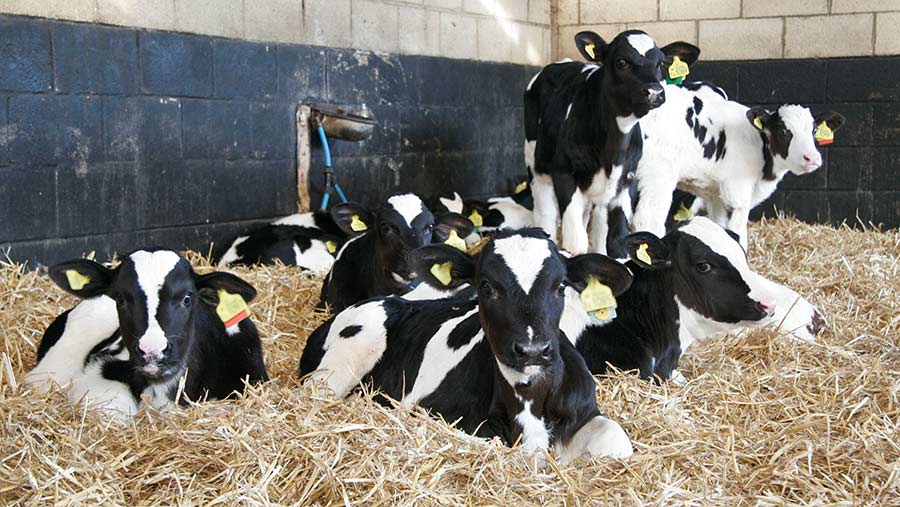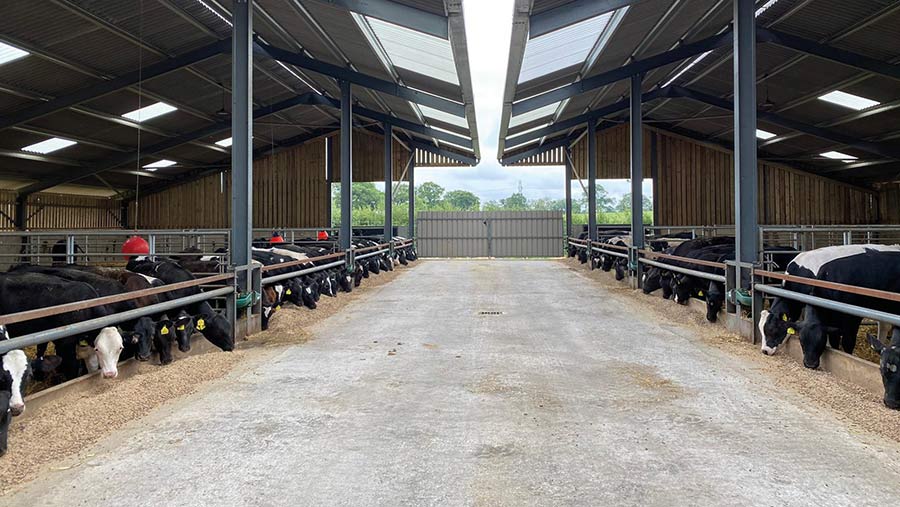How a calf unit has reduced antibiotics use by 60%
 © Tim Scrivener
© Tim Scrivener In the two years that Dominic McKenzie has been farm manager at Long Lane Development Farm in Somerset, the antibiotics use has fallen by 60% at the calf-rearing unit that houses 4,000 animals a year.
A close eye on risk periods and protocol-based management has helped keep a lid on use with no compromise in animal health, keeping mortality at 2%.
See also: UK dairy farmers exceed antibiotics reduction targets
As a Buitelaar-owned research and development facility, with 1,200 calves on the farm at any time, responsible use of antibiotics is very important.
Ben Barber, Buitelaar’s main veterinary advisor, has monthly meetings with Mr McKenzie. These involve reviewing data on antibiotics use and investigating any issues.
“We look at the number of treatments in a batch, the number of treatments per 100 calves and then specifics – where antibiotics have been used and understanding why issues have arisen, so we can focus on those. We look at retreatment rates – it is a good way of measuring treatment success,” he says.
Mr Barber is already able to benchmark the farm with other Synergy Farm Health clients but has also started using the Medicine Hub to record data.
The initial plummet in antibiotics usage at Long Lane has been down to eradicating prophylactic use.
“We don’t ever fall back on prophylactic treatment – as soon as we decided to make the move away from it, we stopped stocking those drugs, so that it was not an option,” Mr McKenzie says.
With a vaccination programme already in place, further reduction has required focus on many different areas throughout the system:
1 Checks by different people
Calves are health-checked twice a day, every day. Previously, one person would check them in the morning and the afternoon, but now morning and afternoon checks are done by two different people.
This has resulted in any issues being picked up a lot quicker.
2 Health checking new arrivals separately
With calves arriving from a mix of farms with different health statuses, issues are most likely to arise in the first two weeks of calves being at the unit.
Therefore, health-checking new arrivals is done separately from health checks on the rest of the unit.
Mr McKenzie explains: “One thousand, two hundred is a lot of calves to check, so having one person concentrating on the newbies helps them to focus on those.”
3 Communication
The team at the unit all have Herdwatch software on their phones and use it for recording treatments and making observation notes on animals.
As well as this, to help communication within the team, they are all in a Whatsapp group that is used to notify each other of medical treatments or calves to keep an eye on.
Medicine Hub
Medicine Hub is a new online database that enables farms to record and monitor antibiotics usage, as well as benchmark against other similar farms – all anonymously.
It is free for farmers and vets to use and sits online, hosted by the AHDB.
Interested farmers can find a comprehensive guide to getting started on the site, or speak to their vets who can upload information on their behalf.
4 Using a thermometer
At the first sign of suspected symptoms, calves will be temperature-checked to see if intervention is required.
5 Feeding protocols
The farm is strict on feeding protocols. All equipment is calibrated, so that volumes and concentrations are accurate, and temperatures are consistent every time.
Calves are fed three litres twice daily mixed at a concentration of 150g of milk powder per litre of water. Milk powder is mixed with water at 50C and is cooled to 42C for feeding.
“Not only is feed one of the biggest variable costs on the farm, but the calves are so dependent on it. We don’t know how developed their rumens are when they arrive, so we have to assume we are the ones doing that,” explains Mr Barber.
6 Cleaning protocols
For both feeding equipment and housing, a strict cleaning protocol covers what products should be used, and at what concentrations.
It also states any disinfectants should be applied to a dry surface, so surfaces must be steam-cleaned, dried and then disinfected.
Feeding equipment is cleaned after each feed and sheds are cleaned and disinfected between batches.
7 Monitoring housing

Calves housed in high health units © Buitelaar
“Your ideal shed is one where you see as little fluctuation in conditions as possible,” says Mr McKenzie. All housing at Long Lane has temperature, ultraviolet and humidity sensors.
After observing that the newer buildings offer a more controlled environment, he has been making tweaks to older sheds.
This has included lifting ridges on roofs and installing a positive-pressure tube ventilation system.
8 Destocking
To improve airflow, they have lowered the stocking density of older sheds. One which previously housed 180 calves now has 120 spaces.
Mr McKenzie says destocking can make a massive difference.
9 Training staff
Every four to six weeks, Mr Barber visits the farm and will train the team.
“It is usually based on an issue on the farm or a particular interest of a staff member, so that it is useful for everyone. It gives something back to the team and it pays back if they can spot something quicker than they otherwise would have,” Mr McKenzie believes.
“We are going to continue to make small changes to older buildings as we are always going to be looking to reduce antibiotics usage further. I think we will also do that by continuing staff training and by using technology – we are always looking for the next bit of technology that will be a viable option with the calves,” he says.
The rearing system at Long Lane
Day one on farm:
- Calves arrive at Long Lane in batches of 150-200 head at around three weeks old and a minimum of 55kg. They remain in these batches throughout
- They receive the first dose of a primary course of a four-in-one vaccine covering parainfluenza 3, bovine respiratory syncytial and bovine viral diarrhoea viruses, as well as Mannheamia haemolytica serotype A1. This is followed up with a booster three weeks later
- Calves are typically put on a 35-day milk plan, which will see them fed 25.2kg of milk powder each and offered 17% protein pellets ad-lib
- Milk is fed in troughs using a 1,000-litre milk taxi
- Calves are bedded on barley straw in a mix of general-purpose livestock sheds and High Health Units, which Buitelar has brought to market.
Two weeks on farm:
- Vaccination for coccidiosis is administered
Three weeks on farm:
- Calves are anaesthetised for disbudding and castration (non-black and whites only). The anaesthetic was introduced eight months ago and heavily reduces stress on the calves
Six weeks on farm:
- Calves are weighed, backs are clipped out and they are treated for flies
- Once calves are consuming 2kg concentrates a day and are around 90kg, they can be weaned from milk and moved to an ad-lib 16% protein blend
10 weeks on farm:
- Calves are weighed, vaccinated against infectious bovine rhinotracheitis (IBR) and treated for flies
12-14 weeks on farm:
- At a minimum of 140kg, calves are moved on to a rearing unit
- Average daily liveweight gain is 1.12kg/day from arrival to 14 weeks
Responsible Use of Medicines in Agriculture Alliance (Ruma) targets
The calf sector targets in the 2022 report published by Ruma are:
- 25% mg/kg fall in calf rearing units by 2024 – with a baseline of 2020/21
- Five fewer treated/100 calves by 2024 – with a baseline of 2020/21
- Calf mortality reduction 1%/year 2020-24 – with a baseline of 2018.
